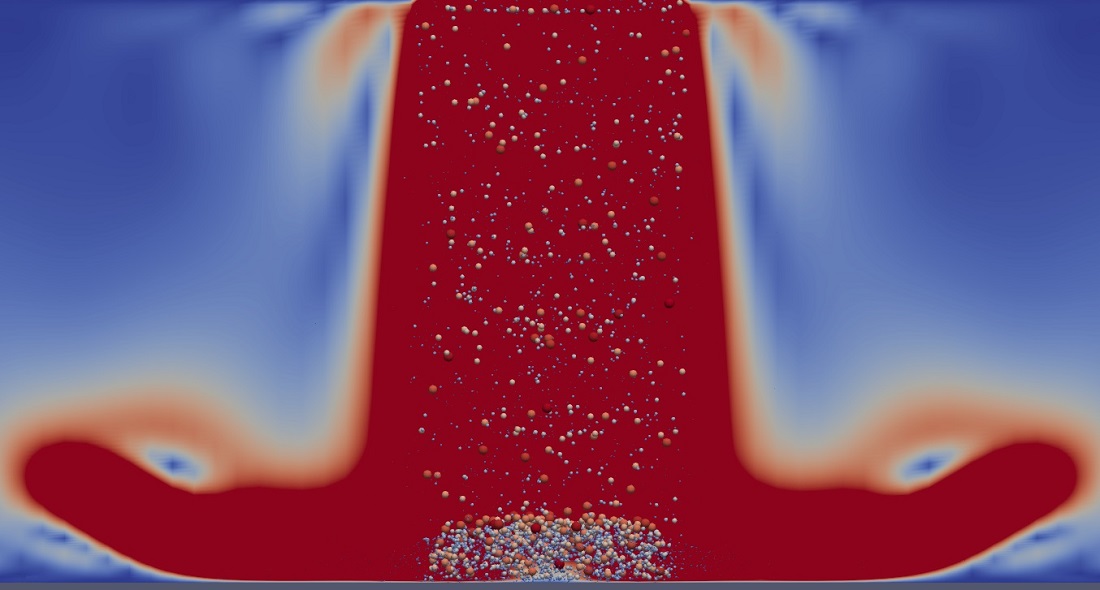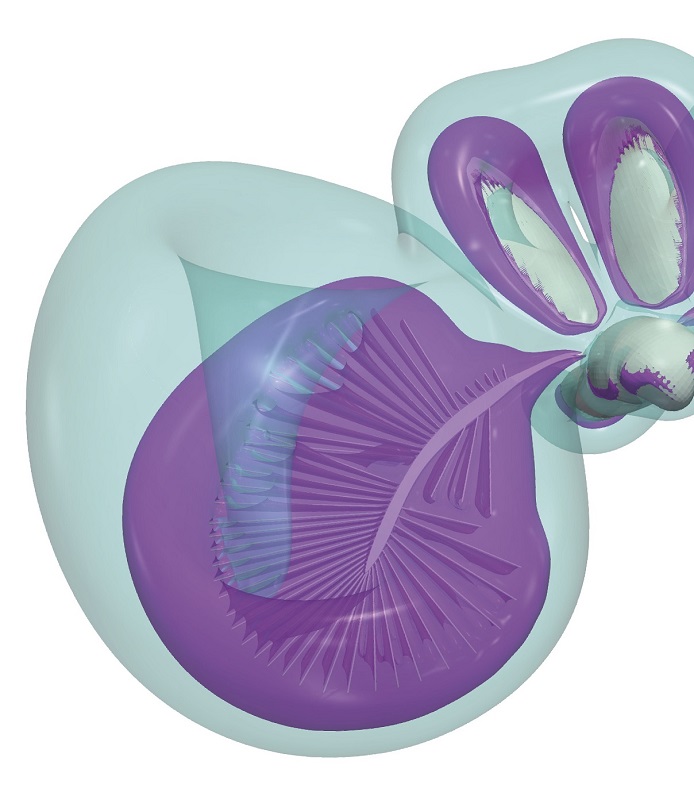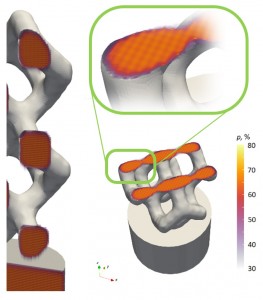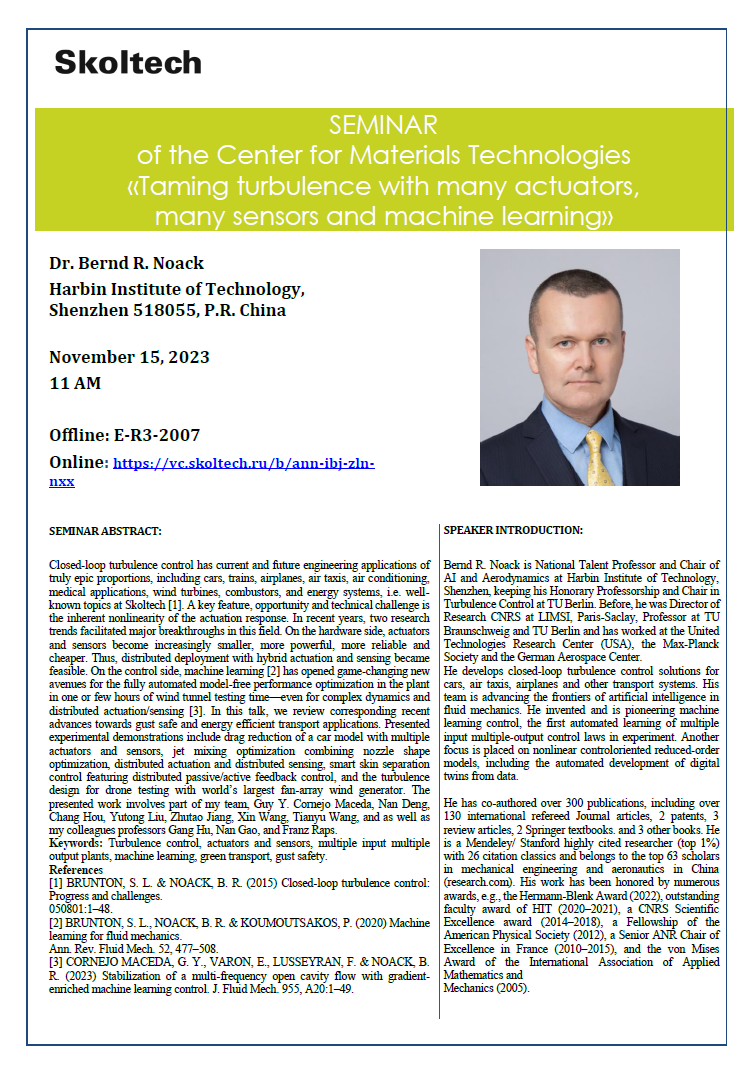Dmitry Kolomenskiy
Center for Materials Technologies
Dr. Dmitry Kolomenskiy is a specialist in fluid mechanics. He received his Ph.D. degree from the University of Aix-Marseille (France), and held academic positions at universities and research institutes in France, Canada and Japan, prior to joining Skoltech. Dr. Kolomenskiy was a postdoctoral fellow at CERFACS (France), McGill University (Canada), Chiba University (Japan), a project scientist at JAMSTEC (Japan), and a specially appointed associate professor at Tokyo Institute of Technology (Japan). In addition, he held visiting fellowships at DAMTP, University of Cambridge (UK), and ESPCI Paris (France). His research concerns mainly with computational fluid dynamics and fluid-solid interaction. His research topics encompass the biolocomotion, vortex dynamics, fluid-solid interaction, and high-performance computing. He develops mathematical models ranging from reduced-order analytical description to direct numerical simulation, on the interface between engineering and biological sciences. He contributed to the development of computational fluid dynamics approaches such as volume penalization and wavelet-based adaptive methods. Besides the work related with the biomechanics, he has been involved in interdisciplinary international collaborative projects with marine biologists, aeronautical engineers, and environmental scientists. His research at Skoltech focuses on the computational fluid dynamics in application to the development of new design and manufacturing processes at CMT.
| Numerical simulation of spray coatingThe gas dynamic spray is a surface coating technique in which coating is formed by treatment of a metallic substrate by a high-velocity impinging particle-laden jet. This process generates a thin layer with a complex nanocrystalline structure in the impingement zone. Optimization of spraying systems continues evolving from an empirical trial and error process to a model-based approach by virtue of the improving completeness and predictive capacity of mathematical models. In this project with the Laboratory of Thermal Spray and Functional Coatings, we perform direct numerical simulation of the particle-laden flow to explore the effect of unsteady vortical structures and particle agglomeration in the impingement layer. |  |
| Biomechanics and biomimeticsMaterials and designs produced by additive manufacturing share similarities with the biological ones in the respect that they are grown by layers, which allows for a great variety of shapes and multi-component structures. Taking this standpoint, we explore the function of such materials and designs in living organisms, with a focus on mechanisms that enable locomotion in air and in water. Follow the links to learn more about the wings of tiny insects and swimming gaits of aquarium fish. |  |
- K. Vilinski-Mazur, B. Kirillov, O. Rogozin, D. Kolomenskiy. Numerical modeling of oxygen diffusion in tissue spheroids undergoing fusion using function representation and finite volumes. Scientific Reports 15:5054, 2025. https://doi.org/10.1038/s41598-025-86805-2
- D. Kolomenskiy. Recent progress in the biomechanics of flight of miniature insects with bristled wings. Journal of the Physical Society of Japan 92:121004, 2023. https://doi.org/10.7566/JPSJ.92.121004
- G. Li, L. Duan, J. Sesterhenn, R. Godoy-Diana, B. Thiria, D. Kolomenskiy. Far-field hydrodynamic interaction in a group of swimmers. Journal of Fluid Mechanics 974:A34, 2023. https://doi.org/10.1017/jfm.2023.802
- G. Li, D. Kolomenskiy, H. Liu, R. Godoy-Diana, B. Thiria. Intermittent versus continuous swimming: An optimization tale. Physical Review Fluids 8(1):013101, 2023. https://doi.org/10.1103/PhysRevFluids.8.013101
- M. Vulf, V. Petrov, A. Sulimov, A. Simonova, A. Kazak, S. Chugunov, D. Kolomenskiy. A novel droplet generator and a bench-testing rig enabling research on suspension droplet wall impingement and particle deposition. Coatings 13(1):129, 2023. https://doi.org/10.3390/coatings13010129
- R. Onishi, J. Hirai, D. Kolomenskiy, Y. Yasuda. Real-time high-resolution prediction of orographic rainfall for early warning of landslides.
Progress in Landslide Research and Technology 1(1):237–248, 2022. https://doi.org/10.1007/978-3-031-16898-7_17 - S. E. Farisenkov, D. Kolomenskiy, P. N. Petrov, T. Engels, N. A. Lapina, F.-O. Lehmann, R. Onishi, H. Liu, A. A. Polilov. Novel flight style and light wings boost flight performance of tiny beetles. Nature 602:96-100, 2022. https://doi.org/10.1038/s41586-021-04303-7
- T. Engels, H. Truong, M. Farge, D. Kolomenskiy, K. Schneider. Computational aerodynamics of insect flight using volume penalization. Comptes Rendus. Mécanique, online first, 1–20, 2022. https://doi.org/10.5802/crmeca.129
- G. Li, D. Kolomenskiy, H. Liu, B. Thiria, R. Godoy-Diana. Hydrodynamical fingerprint of a neighbour in a fish lateral line. Frontiers in Robotics and AI 9:825889, 2022. https://doi.org/10.3389%2Ffrobt.2022.825889
- X. Cai, Y. Xue, D. Kolomenskiy, R. Xu, H. Liu. Elastic storage enables robustness of flapping wing dynamics. Bioinspiration & Biomimetics 17:045003, 2022. https://doi.org/10.1088/1748-3190/ac6c66
- D. Kolomenskiy, R. Onishi, H. Uehara. WaveRange: wavelet-based data compression for three-dimensional numerical simulations on regular grids. Journal of Visualization 25:543–573, 2022. https://doi.org/10.1007/s12650-021-00813-8
- H. Truong, T. Engels, H. Wehmann, D. Kolomenskiy, F.-O. Lehmann, K. Schneider. An experimental data-driven mass-spring model of flexible Calliphora wings, Bioinspiration & Biomimetics 17:026003, 2022. https://doi.org/10.1088/1748-3190/ac2f56
- Y. Yasuda, R. Onishi, Y. Hirokawa, D. Kolomenskiy, D. Sugiyama. Super-resolution of near-surface temperature utilizing physical quantities for real-time prediction of urban micrometeorology. Building and Environment 209:108597, 2022. https://doi.org/10.1016/j.buildenv.2021.108597
- T. Engels, D. Kolomenskiy, F.-O. Lehmann. Flight efficiency is a key to diverse wing morphologies in small insects. Journal of the Royal Society Interface, 18(183):20210518, 2021. https://doi.org/10.1098/rsif.2021.0518
- X. Cai, D. Kolomenskiy, T. Nakata, H. Liu. A CFD data-driven aerodynamic model for fast and precise prediction of flapping aerodynamics in various flight velocities. Journal of Fluid Mechanics 915:A114, 2021. https://doi.org/10.1017/jfm.2021.68
- G. Li, I. Ashraf, B. François, D. Kolomenskiy, F. Lechenault, R. Godoy-Diana, B. Thiria. Burst-and-coast swimmers optimize gait by adapting unique intrinsic cycle. Communications Biology 4:40, 2021. https://doi.org/10.1038/s42003-020-01521-z
- H. Truong, T. Engels, D. Kolomenskiy, K. Schneider. Influence of wing flexibility on the aerodynamic performance of a tethered flapping bumblebee. Theoretical and Applied Mechanics Letters 10:382-389, 2020. https://doi.org/10.1016/j.taml.2020.01.056
- D. Kolomenskiy, S. Farisenkov, T. Engels, N. Lapina, P. Petrov, F.-O. Lehmann, R. Onishi, H. Liu, A. Polilov. Aerodynamic performance of a bristled wing of a very small insect. Experiments in Fluids 61:194, 2020. https://doi.org/10.1007/s00348-020-03027-0
- H. Truong, T. Engels, D. Kolomenskiy, K. Schneider. A mass-spring fluid-structure interaction solver: Application to flexible revolving wings. Computers & Fluids 200:104426, 2020. https://doi.org/10.1016/j.compfluid.2020.104426
- S. Ravi, R. Noda, S. Gagliardi, D. Kolomenskiy, S. Combes, H. Liu, A. Biewener, N. Konow. Modulation of flight muscle recruitment and wing rotation enables hummingbirds to mitigate aerial roll perturbations. Current Biology 30:187-195, 2020. https://doi.org/10.1016/j.cub.2019.11.025
- G. Li, D. Kolomenskiy, H. Liu, B. Thiria, R. Godoy-Diana. On the energetics and stability of a minimal fish school. PLoS One 14(8):e0215265, 2019. https://doi.org/10.1371/journal.pone.0215265
- D. Kolomenskiy, S. Ravi, R. Xu, K. Ueyama, T. Jakobi, T. Engels, T. Nakata, J. Sesterhenn, M. Farge, K. Schneider, R. Onishi, H. Liu. Wing morphology and inertial properties of bumblebees. Journal of Aero Aqua Bio-mechanisms 8(1):41-47, 2019. https://doi.org/10.5226/jabmech.8.41
- G. Li, D. Kolomenskiy, H. Liu, B. Thiria, R. Godoy-Diana. On the interference of vorticity and pressure fields of a minimal fish school. Journal of Aero Aqua Bio-mechanisms 8(1):27-33, 2019. https://doi.org/10.5226/jabmech.8.27
- D. Kolomenskiy, S. Ravi, R. Xu, K. Ueyama, T. Jakobi, T. Engels, T. Nakata, J. Sesterhenn, K. Schneider, R. Onishi, H. Liu. The dynamics of passive feathering rotation in hovering flight of bumblebees. Journal of Fluids and Structures 91:102628, 2019. https://doi.org/10.1016/j.jfluidstructs.2019.03.021
- T. Engels, D. Kolomenskiy, K. Schneider, M. Farge, F.-O. Lehmann, J. Sesterhenn. Impact of turbulence on flying insects in tethered and free flight: high-resolution numerical experiments. Physical Review Fluids 4:013103, 2019. https://doi.org/10.1103/PhysRevFluids.4.013103
- D. Chen, D. Kolomenskiy, R. Onishi, H. Liu. Versatile reduced-order model of leading-edge vortices on rotary wings. Physical Review Fluids 3:114703, 2018. https://doi.org/10.1103/PhysRevFluids.3.114703
- T. Jakobi, D. Kolomenskiy, T. Ikeda, S. Watkins, A. Fisher, H. Liu, S. Ravi. Bees with attitude: the effects of directed gusts on flight trajectories. Biology Open 7:bio034074, 2018. https://doi.org/10.1242/bio.034074
- D. Kolomenskiy, R. Paoli. Numerical simulation of the wake of an airliner. Journal of Aircraft 55(4):1689-1699, 2018. https://doi.org/10.2514/1.C034349
- T. Engels, D. Kolomenskiy, K. Schneider, M. Farge, F.-O. Lehmann, J. Sesterhenn. Helical vortices generated by flapping wings of bumblebees. Fluid Dynamics Research 50(1):011419, 2018. https://doi.org/10.1088/1873-7005/aa908f
- D. Chen, D. Kolomenskiy, T. Nakata, H. Liu. Forewings match the formation of leading-edge vortices and dominate aerodynamic force production in revolving insect wings. Bioinspiration & Biomimetics 13(1):016009, 2018. https://doi.org/10.1088/1748-3190/aa94d7
- D. Chen, D. Kolomenskiy, H. Liu. Closed-form solution for the edge vortex of a revolving plate. Journal of Fluid Mechanics 821:200-218, 2017. https://doi.org/10.1017/jfm.2017.257
- H. Liu, D. Kolomenskiy, T. Nakata, G. Li. Unsteady bio-fluid dynamics in flying and swimming. Acta Mechanica Sinica 33(4):663-684, 2017. https://doi.org/10.1007/s10409-017-0677-4
- S. Ravi, D. Kolomenskiy, T. Engels, K. Schneider, C. Wang, J. Sesterhenn, H. Liu. Bumblebees minimize control challenges by combining active and passive modes in unsteady winds. Scientific Reports 6:35043, 2016. https://doi.org/10.1038/srep35043
- T. Engels, D. Kolomenskiy, K. Schneider, J. Sesterhenn. FluSI: a novel parallel simulation tool for flapping insect flight using a Fourier method with volume penalization. SIAM Journal on Scientific Computing 38(5):S3-S24, 2016. https://doi.org/10.1137/15M1026006
- H. Liu, S. Ravi, D. Kolomenskiy, H. Tanaka. Biomechanics and biomimetics in insect-inspired flight systems. Philosophical Transactions of the Royal Society B: Biological Sciences, 371(1704):20150390, 2016. https://doi.org/10.1098/rstb.2015.0390
- D. Kolomenskiy, M. Maeda, T. Engels, H. Liu, K. Schneider, J.-C. Nave. Aerodynamic ground effect in fruitfly sized insect takeoff. PLoS One 11(3):e0152072, 2016. https://doi.org/10.1371/journal.pone.0152072
- T. Engels, D. Kolomenskiy, K. Schneider, F.-O. Lehmann and J. Sesterhenn. Bumblebee flight in heavy turbulence. Physical Review Letters 116:028103, 2016. https://doi.org/10.1103/PhysRevLett.116.028103
- D. Kolomenskiy, J.-C. Nave, K. Schneider. Adaptive gradient-augmented level set method with multiresolution error estimation. Journal of Scientific Computing 66(1):116-140, 2016. https://doi.org/10.1007/s10915-015-0014-7
- T. Engels, D. Kolomenskiy, K. Schneider, J. Sesterhenn. Numerical simulation of fluid-structure interaction with the volume penalization method. Journal of Computational Physics 281:96-115, 2015. https://doi.org/10.1016/j.jcp.2014.10.005
- D. Kolomenskiy, R. Nguyen van yen, K. Schneider. Analysis and discretization of the volume penalized Laplace operator with Neumann boundary conditions. Applied Numerical Mathematics 95:238-249, 2015. https://doi.org/10.1016/j.apnum.2014.02.003
- R. Nguyen van yen, D. Kolomenskiy, K. Schneider. Approximation of the Laplace and Stokes operators with Dirichlet boundary conditions through volume penalization: a spectral viewpoint. Numerische Mathematik 128(2):301-338, 2014. https://doi.org/10.1007/s00211-014-0610-8
- D. Kolomenskiy, Y. Elimelech, K. Schneider. Leading-edge vortex shedding from rotating wings. Fluid Dynamics Research 46:031421, 2014. https://doi.org/10.1088/0169-5983/46/3/031421
- G. Bimbard, D. Kolomenskiy, J. Casas, R. Godoy-Diana. Large kinematic variability during take-off in butterflies due to varying relative timing of legs and aerodynamic forces. Journal of Experimental Biology 216:3551-3563, 2013. https://doi.org/10.1242/jeb.084699
- T. Engels, D. Kolomenskiy, K. Schneider, J. Sesterhenn. Numerical simulation of the fluttering instability using a pseudospectral method with volume penalization. Computers and Structures 122:101-112, 2013. https://doi.org/10.1016/j.compstruc.2012.12.007
- D. Kolomenskiy, H. K. Moffatt. Similarity solutions for unsteady stagnation point flow. Journal of Fluid Mechanics 711:394-410, 2012. https://doi.org/10.1017/jfm.2012.397
- B. Kadoch, D. Kolomenskiy, P. Angot, K. Schneider. A volume penalization method for incompressible flows and scalar advection-diffusion with moving obstacles. Journal of Computational Physics 231:4365-4383, 2012. https://doi.org/10.1016/j.jcp.2012.01.036
- D. Kolomenskiy, H. K. Moffatt, M. Farge, K. Schneider. Two- and three-dimensional numerical simulations of the clap-fling-sweep of hovering insects. Journal of Fluids and Structures 27(5-6):784-791, 2011. https://doi.org/10.1016/j.jfluidstructs.2011.05.00
- D. Kolomenskiy, H. K. Moffatt, M. Farge, K. Schneider. The Lighthill – Weis-Fogh clap-fling-sweep mechanism revisited. Journal of Fluid Mechanics 676:572-606, 2011. https://doi.org/10.1017/jfm.2011.83
- D. Kolomenskiy, K. Schneider. Numerical simulations of falling leaves using a pseudo-spectral method with volume penalization. Theoretical and Computational Fluid Dynamics 24(1-4):169-173, 2010. https://doi.org/10.1007/s00162-009-0171-0
- D. Kolomenskiy, H. K. Moffatt, M. Farge, K. Schneider. Vorticity generation during the clap-fling-sweep of some hovering insects. Theoretical and Computational Fluid Dynamics 24(1-4):209-215, 2010. https://doi.org/10.1007/s00162-009-0137-2
- D. Kolomenskiy, K. Schneider. A Fourier spectral method for the Navier-Stokes equations with volume penalization for moving solid obstacles. Journal of Computational Physics 228:5687-5709, 2009. https://doi.org/10.1016/j.jcp.2009.04.026
- R. Nguyen van yen, M. Farge, D. Kolomenskiy, K. Schneider, N. Kingsbury. Wavelets meet Burgulence: CVS-filtered Burgers equation. Physica D 237:2151-2157, 2008. https://doi.org/10.1016/j.physd.2008.02.011
09.11.2023
The next research seminar of the Center for Materials Technologies is scheduled for Wednesday, November 15, 11 AM.
Our speaker is Dr. Bernd R. Noack, Chair of Artificial Intelligence and Aerodynamics (CAIA), School of Mechanical Engineering and Automation, Harbin Institute of Technology, Shenzhen, China, with the topic “Taming turbulence with many actuators, many sensors and machine learning”.
The seminar will be held in hybrid mode.
Offline: E-R3-2007
Online: Join via https://vc.skoltech.ru/b/ann-ibj-zln-nxx
Numerical Methods in Engineering and Applied Science (6 ECTS)
The course provides students with the understanding and working knowledge of fundamentals of numerical methods used for modeling and simulation of complex phenomena described by ordinary and partial differential equations. The following topics are covered: finite-difference approximation of derivatives; interpolation; integration; steady-state boundary value problems; local and global errors; stability, consistency, and convergence; matrix equations and iterative methods; initial value problems for ordinary differential equations; Runge-Kutta methods; multi-step methods; absolute stability; stiff ODE; numerical solution of PDEs; parabolic problems; hyperbolic problems; method of lines; von Neumann analysis; operator splitting; introduction to spectral approximation.
The course involves hands-on experience with programming (in Matlab or Python) and solving problems on computers. Solid knowledge of undergraduate mathematics including basic understanding of the theory of ordinary and partial differential equations of physics and engineering as well as basic programming skills are required.
Computational Fluid Dynamics (6 ECTS)
Fluid flows are ubiquitous in engineering. Fluid mechanics provides the theoretical foundation to a broad spectrum of engineering applications that range from tiny laboratory-on-a-chip devices to the largest thermal and hydroelectric power plants. The rich dynamics of fluid motion leads to numerous effects that engineers may wish to exploit or suppress. Mathematical description of fluid flows most commonly involves non-linear partial differential equations that make analytical solution impossible or impractical. Therefore, approximate solution using numerical methods has been widely implemented since the advent of digital computers. Nowadays, the Computational Fluid Dynamics (CFD) is a well-established discipline. CFD is widely used in science and engineering alike. It accelerates optimal design and offers important insights in the flow dynamics.
The course will introduce the students to important theoretical and practical aspects of the CFD. It will explain how to describe the fluid flow by partial differential equations with suitable initial and boundary conditions, and how to transform those equations into computer algorithms. A brief overview of general-purpose numerical methods will be provided, with comments on their relevance to the CFD. Then, specialized methods for different types of flows will be introduced. This will be followed by a brief discussion of the advanced topics of fluid-structure interaction, turbulence modelling and high-performance computing. Computer practice classes will allow the students to acquire basic skills of programming simple methods from scratch, get acquainted with existing CFD software packages, develop intuition for distinguishing physical effects from numerical artifacts, and learn to use the CFD wisely.


